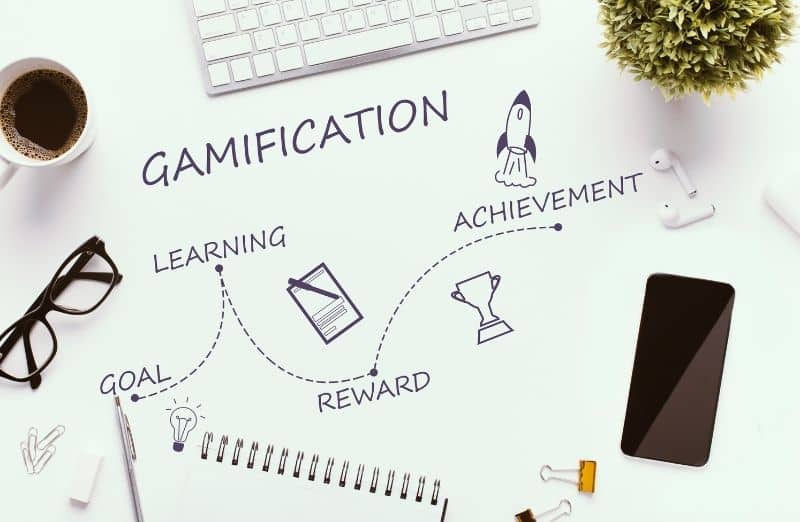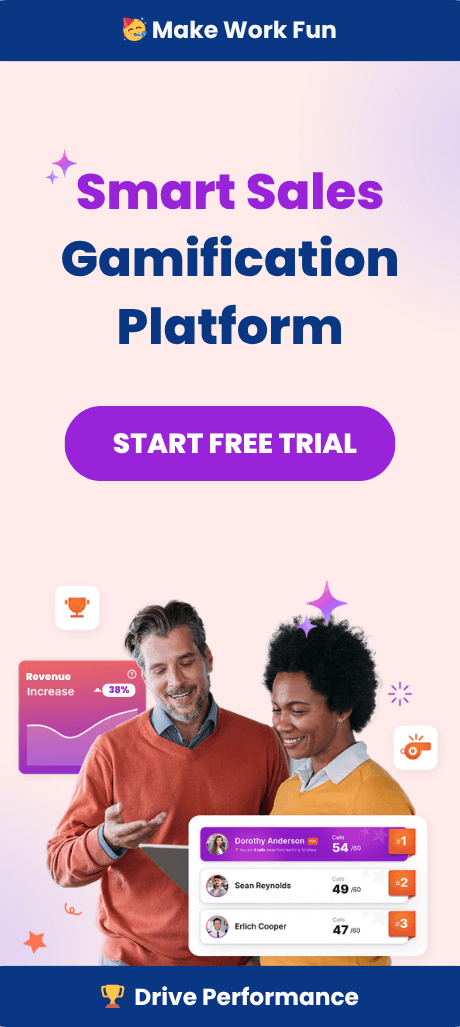Gone are the days of going to the office, clocking in for your 9-5, and commuting home after a long day of emails and phone calls. Employees want more these days. They want to be engaged with their workweek tasks and feel passionate about their contributions. They want to feel satisfied and fulfilled by their work week and be excited to take on new opportunities and projects.
Digital games have evolved significantly, integrating into various fields like education, marketing, and corporate training. The financial growth of digital games and their mechanics are increasingly being utilized to enhance user engagement and motivation in a range of online activities.
One of the best ways to create a thriving workplace dynamic that fulfills your team’s needs and keeps them engaged is gamification. This isn’t an old trend by any means. Still, over the last few years, new software and AI-driven tools have become more readily available, making using gamification in the workplace easier than ever.

Over the next few years, we’re sure this trend will continue to grow and shape the workplace dynamic as we know it. If you want to stay competitive and find innovative ways to engage with your team, you’ll want to stay in the know about the latest trends and software.
We’re here to walk you through the gamification trends shaping the future of gamification and paving the way for innovation.
Let’s take a closer look:
What is Gamification?

Gamification is the process of using game elements in a non-game context. Companies of every size and across different industries are seeing the true potential of gamifying the workplace experience by incorporating game playing, which emphasizes the interactive and competitive aspects of games to enhance learning, engagement, and motivation. With the right tools, software, and strategy – your business has a unique opportunity to make the workplace experience fun and engaging.
So – when your team members clock in to start their day, they’ll think of their workweek tasks as a game rather than a chore. As there continue to be more advancements with gamification, we’re sure to see more innovative solutions grow from gamification.
Definition and Overview
Gamification is the process of incorporating game design elements and mechanics into non-game contexts to engage and motivate people to achieve their goals. By leveraging natural human desires for competition, achievement, status, and collaboration, gamification drives user engagement and participation. Whether it’s earning points, unlocking badges, or climbing leaderboards, these game elements make everyday tasks more enjoyable and rewarding. Gamification can be applied across various industries, including education, marketing, and employee engagement, to create interactive and immersive experiences that captivate and motivate users.
Current State of Gamification
The current state of gamification is marked by its widespread adoption across diverse sectors. According to recent statistics, the global gamification market is projected to reach a staggering $48.72 billion by 2029, growing at a compound annual growth rate (CAGR) of 12.9% between now and 2025. The retail industry leads the charge in utilizing gamification, closely followed by the education sector. Companies are increasingly turning to gamification to enhance employee engagement, foster customer loyalty, and improve user experience. This growing trend underscores the significant impact gamification is having on various aspects of business and consumer interaction.
In addition to its financial growth, gamification is reshaping how businesses approach customer interaction and employee motivation. By integrating game mechanics into everyday tasks, companies are finding innovative ways to encourage users and drive engagement. For example, gamification tools are being used to transform mundane tasks into exciting challenges, motivating employees to perform better and stay engaged. The use of digital rewards, progress bars, and virtual badges is becoming more commonplace, providing immediate feedback and recognition, which are key drivers of motivation.
Moreover, gamification is not limited to traditional industries. Emerging fields such as healthcare and finance are also exploring gamified solutions to enhance user experiences and drive better outcomes. In healthcare, gamification is being used to promote healthy behaviors and improve patient adherence to treatment plans. In finance, gamified systems are helping to educate customers about financial products and encourage better financial habits.
As gamification continues to evolve, it is expected to provide more robust data and insights for businesses. By analyzing user behavior and engagement metrics, companies can gain valuable insights into customer preferences and tailor their strategies accordingly. This data-driven approach enables continuous improvement of gamification strategies, ensuring they remain effective and relevant in a rapidly changing market.
Overall, the current state of gamification signifies a shift towards more interactive and engaging experiences across various industries. As businesses continue to embrace gamification strategies, we can expect to see further innovation and growth in this dynamic field.
Market Growth and Adoption

The gamification market is on a trajectory of impressive expansion, driven by the rising demand for interactive and engaging experiences. This growth is fueled by the increasing adoption of gamification strategies across multiple industries, including education, marketing, and employee engagement. Companies are embracing gamified elements such as points, badges, and leaderboards to boost user engagement and participation. As a result, investments in gamification platforms are surging, reflecting the commitment of businesses to leverage these tools for enhanced user experiences and improved outcomes.
As gamification continues to evolve, its impact is being felt across various sectors, leading to a transformative shift in how businesses operate. The integration of gamified elements into everyday tasks is not only enhancing productivity but also fostering a culture of continuous improvement and innovation. Businesses are recognizing the potential of gamification to drive employee motivation and customer loyalty, leading to a more dynamic and interactive work environment.
Moreover, the global gamification market is witnessing rapid growth due to technological advancements such as artificial intelligence and virtual reality. These technologies are enabling companies to create more personalized and immersive gamified experiences, further driving user engagement and satisfaction. The incorporation of AI in gamification solutions allows for real-time feedback and data-driven insights, helping businesses to analyze user behavior and tailor their strategies accordingly.
The future of gamification looks promising, with emerging trends such as blockchain technology and augmented reality poised to revolutionize the industry. These innovations are expected to provide even more robust data and insights, enabling companies to refine their gamification strategies and achieve better outcomes. As the market continues to expand, businesses that embrace gamification will be well-positioned to stay ahead of the competition and capitalize on the opportunities it presents.
In conclusion, the gamification market is experiencing unprecedented growth, driven by the increasing demand for engaging and interactive experiences. By leveraging gamification strategies, companies can enhance user engagement, improve employee motivation, and foster customer loyalty, ultimately leading to better business outcomes. As technology continues to advance, the potential for gamification to transform various industries is limitless, making it an essential tool for businesses looking to thrive in today’s dynamic market.
Five Gamification Trends For 2025
The beauty of gamification is its versatility. There are countless ways to utilize these tools in the workplace to improve engagement, productivity, and company morale.
Here are five gamification trends to consider incorporating:
Gamification in Onboarding with Game Design Elements
The onboarding process at most companies is outdated and somewhat… Boring. New hires are asked to read and sign the paperwork, watch dated tutorials, and complete training they’ll probably forget about in the upcoming weeks.
Companies are now finding ways to use gamification to engage with their new hires to help them retain more information during the onboarding process. Whether it’s pop quizzes, mini-games, or a virtual interactive training program – these game mechanics can help team members retain more information and feel engaged throughout their onboarding. These game elements also help businesses enhance their company culture and boost morale in the early stages of employment.

Incorporating serious game techniques into onboarding can further enhance educational and problem-solving strategies, making the process more effective and engaging.
Now that the job market is more competitive than ever, it pays to improve staff retention and attrition rates by creating onboarding processes that engage new hires. Studies suggest that companies with well throughout onboarding processes can increase new hire retention by 82% and enhance productivity by 70%. In 2025 and beyond, we’re sure to see more businesses use the power of gamification to create a next-level onboarding process.
Gamification in Sales
Sales managers and leaders in the workplace have been using gamification to inspire sales reps to go above and beyond for a while. Sales contests, bonuses, and additional commissions are just a few of the most common elements that push sales reps to make a few extra calls or send emails throughout the week.
But now, companies are finding fun and creative ways to keep their sales team engaged with their goals beyond a holiday bonus or prizes.
Gamification sales software like Spinify is designed to inspire friendly competition and provide a new perspective to the sales process. Every time your sales reps clock in to start their day, they’ll be greeted with a leaderboard or a progress bar, so they can visualize their success. Every week or month, you can host mini-competitions to motivate team members to do more and be excited to do so.
We’re sure to see gamification continue to be a driving force for motivation with sales teams in 2025 and the years to follow.
Building Online Communities
Community building through gamification brings people together by enhancing user engagement through social connectivity. It’s a tool that inspires your team members to communicate and collaborate more effectively. Businesses that invite the best gamification tools and software into their workplace can use them to keep their team connected, no matter where they are.

In the upcoming years, companies with a remote-first workplace can use gamification to keep remote team members engaged with everyday tasks and build a company culture that thrives off friendly competition, communication, and collaboration. Over the next few years, we’ll see online communities powered by gamification grow.
Different Sectors Use Gamification Strategies
Gamification is nothing new for customer service, marketing, or sales teams. Reward systems and leaderboards have been used to help team members stay on track with their goals for years. However, we’re now seeing more industries use game elements in their strategies to help other departments flourish.
For example, hospitality and automotive companies are finding ways to use gamification and AI to develop interactive online training programs for team members. Departments within a business, like financial and accounting, can also capitalize on these tools to inspire team members to complete mundane tasks or get ahead of the workweek. As gamification becomes more advanced, it will be more of a necessity across every department at a business.
The Rise of Gamification and AI
Artificial intelligence is more than just a buzzword. The recent developments in AI have influenced when, where, and how brands can use gamification. In 2025 and beyond, gamification and AI will work together to provide innovative solutions to companies and their employees.
At Spinify, we’ve recently developed a tool called Spinify GPT Sidekick. This AI-powered gamification tool integrates the game mechanics into your workweek and is designed to keep employees engaged with their everyday tasks.
By leveraging AI to analyze user behavior, we can tailor challenges and rewards to ensure a personalized experience. This data-driven insight helps refine gamification strategies, making them more effective and engaging.

With Spinify Sidekick, your team will have a personalized gamification experience. They’ll stay engaged with smarter competitions, achievements with in-built custom messages, and motivational badges that align with their goals and personal progress.
Our tool takes gamification to the next level. It ensures that the game elements you use to engage with your sales team are always top of mind, automated, and working in the background of your 9-5.
Spinify Sidekick is paving the way for innovation and is just one stepping stone toward its full potential. As AI continues to advance, so will Spinify Sidekick – so you can feel confident that you’ll always be two steps ahead of the trends.
Gamification Trends for Consumers
The workplace isn’t the only place we’re seeing gamification grow. Businesses also use these tools to engage with consumers, employees, and partners. This is a trending tool businesses can use to connect with customers and build a more engaging experience.
Here’s how other businesses are currently testing the waters with gamification:
Gamified Mobile Apps

Mobile apps are arguably the most popular way to commercialize gamification. Big-named brands use gamification to keep consumers engaged with their products and services on their mobile devices.
This has proven to be a successful approach. Gamification is used in everything from fitness apps to loyalty programs and learning platforms. As smartphone usage continues to rise and more brands will prioritize the mobile user experience, we’re sure to see gamification continue to grow and change.
The integration of gamified elements in mobile apps is not only limited to entertainment but also extends to various sectors such as health, education, and finance. Fitness apps, for example, use gamification strategies like progress bars, virtual badges, and reward systems to motivate users to achieve their fitness goals. These gamified features encourage users to stay engaged and maintain their workout routines by providing a sense of achievement and competition.
In the education sector, mobile apps are leveraging gamified learning to make studying more interactive and enjoyable. By incorporating game mechanics such as quizzes, challenges, and leaderboards, educational apps are transforming the learning experience, making it more engaging for students of all ages.
Financial apps are also embracing gamification to encourage better financial habits. By using game design elements like point systems and achievement badges, these apps help users track their spending, save money, and reach financial milestones, promoting a more disciplined approach to personal finance.
As the global gamification market continues to expand, the potential for gamified mobile apps to revolutionize user engagement across different industries is immense. By analyzing user behavior and feedback, app developers can refine their gamification strategies to create more personalized and impactful experiences that resonate with users. This continuous improvement ensures that gamified mobile apps remain at the forefront of innovation, driving higher levels of user satisfaction and loyalty.
Gamification in Education
With the rise of online education comes the need to keep individuals engaged with their studies. We live in a world that is surrounded by distractions. With the help of gamification, teachers and educators have a unique opportunity to keep their team members engaged with the curriculum.

Whether it’s an interactive quiz, mini-games, or badges for reaching milestones, in the upcoming years, game elements and mechanics will completely revolutionize educators’ approach to their curriculum. They’ll find ways to use their resources to engage with team members that are not only effective – but fun!
AR, VR, and MR in Gamification
Augmented Reality (AR), Virtual Reality (VR), and Mixed Reality (MR) are revolutionizing gamification by creating more immersive and interactive experiences. Companies like Exxon Mobil and Walmart are already incorporating these cutting-edge technologies into their gamified training programs, offering employees a more engaging and effective learning environment. The use of AR, VR, and MR in gamification is expected to continue growing, enabling companies to deliver better gamified experiences that captivate users and drive higher levels of engagement. As these technologies evolve, they will play a crucial role in shaping the future of gamification.
Gamification and Data Analysis
Gamification is not just about creating interactive experiences; it’s also about analyzing user behavior and preferences to refine gamification strategies. Data-driven gamification is becoming increasingly important as companies seek to understand how users interact with gamified experiences and optimize them for better engagement and participation. By leveraging data analytics, companies can track user behavior, identify trends, and make data-driven decisions to enhance gamified experiences. This approach ensures that gamification strategies are continuously improved, leading to more effective and engaging outcomes for users.
Gamify The Sales Process With Spinify
Ready to jump on the gamification trend? You’ve come to the right place. At Spinify, we have everything you need to create a next-level gamification strategy for you and your sales team.
Whether you’re looking for progress bars, leaderboards, or badges to give to your team when they reach a new milestone -we have everything you need to keep your team engaged from start to finish.
Book a demo today to start experiencing the Spinify difference.



